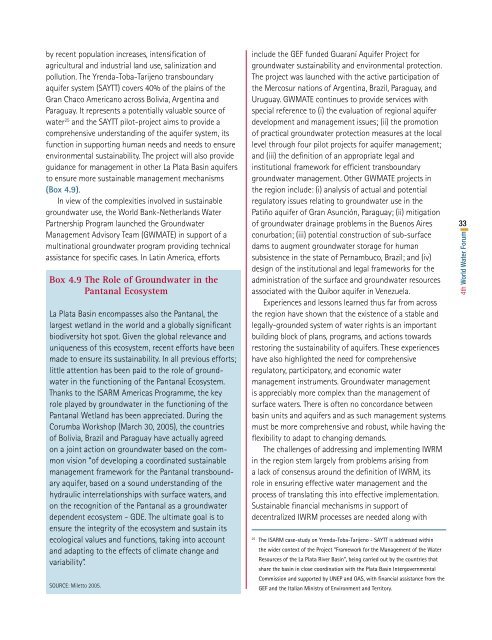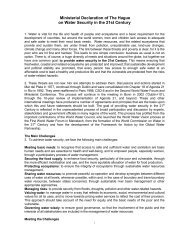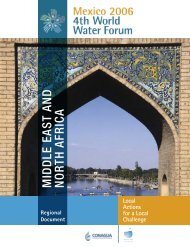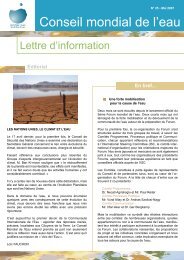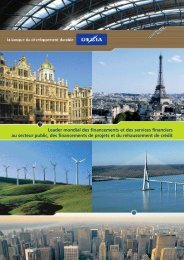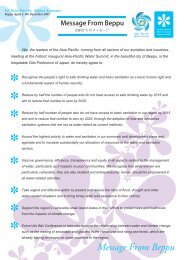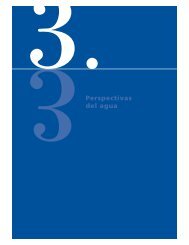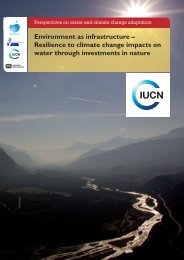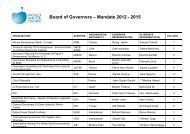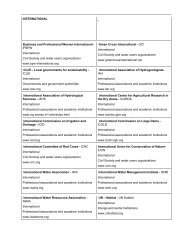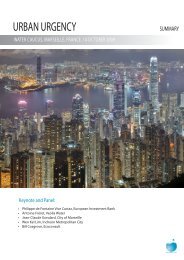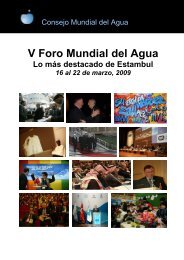Americas ok.indd - World Water Council
Americas ok.indd - World Water Council
Americas ok.indd - World Water Council
You also want an ePaper? Increase the reach of your titles
YUMPU automatically turns print PDFs into web optimized ePapers that Google loves.
y recent population increases, intensification ofagricultural and industrial land use, salinization andpollution. The Yrenda-Toba-Tarijeno transboundaryaquifer system (SAYTT) covers 40% of the plains of theGran Chaco Americano across Bolivia, Argentina andParaguay. It represents a potentially valuable source ofwater 25 and the SAYTT pilot-project aims to provide acomprehensive understanding of the aquifer system, itsfunction in supporting human needs and needs to ensureenvironmental sustainability. The project will also provideguidance for management in other La Plata Basin aquifersto ensure more sustainable management mechanisms(Box 4.9).In view of the complexities involved in sustainablegroundwater use, the <strong>World</strong> Bank-Netherlands <strong>Water</strong>Partnership Program launched the GroundwaterManagement Advisory Team (GWMATE) in support of amultinational groundwater program providing technicalassistance for specific cases. In Latin America, effortsBox 4.9 The Role of Groundwater in thePantanal EcosystemLa Plata Basin encompasses also the Pantanal, thelargest wetland in the world and a globally significantbiodiversity hot spot. Given the global relevance anduniqueness of this ecosystem, recent efforts have beenmade to ensure its sustainability. In all previous efforts;little attention has been paid to the role of groundwaterin the functioning of the Pantanal Ecosystem.Thanks to the ISARM <strong>Americas</strong> Programme, the keyrole played by groundwater in the functioning of thePantanal Wetland has been appreciated. During theCorumba Workshop (March 30, 2005), the countriesof Bolivia, Brazil and Paraguay have actually agreedon a joint action on groundwater based on the commonvision “of developing a coordinated sustainablemanagement framework for the Pantanal transboundaryaquifer, based on a sound understanding of thehydraulic interrelationships with surface waters, andon the recognition of the Pantanal as a groundwaterdependent ecosystem - GDE. The ultimate goal is toensure the integrity of the ecosystem and sustain itsecological values and functions, taking into accountand adapting to the effects of climate change andvariability”.SOURCE: Miletto 2005.include the GEF funded Guaraní Aquifer Project forgroundwater sustainability and environmental protection.The project was launched with the active participation ofthe Mercosur nations of Argentina, Brazil, Paraguay, andUruguay. GWMATE continues to provide services withspecial reference to (i) the evaluation of regional aquiferdevelopment and management issues; (ii) the promotionof practical groundwater protection measures at the locallevel through four pilot projects for aquifer management;and (iii) the definition of an appropriate legal andinstitutional framework for efficient transboundarygroundwater management. Other GWMATE projects inthe region include: (i) analysis of actual and potentialregulatory issues relating to groundwater use in thePatiño aquifer of Gran Asunción, Paraguay; (ii) mitigationof groundwater drainage problems in the Buenos Airesconurbation; (iii) potential construction of sub-surfacedams to augment groundwater storage for humansubsistence in the state of Pernambuco, Brazil; and (iv)design of the institutional and legal frameworks for theadministration of the surface and groundwater resourcesassociated with the Quibor aquifer in Venezuela.Experiences and lessons learned thus far from acrossthe region have shown that the existence of a stable andlegally-grounded system of water rights is an importantbuilding block of plans, programs, and actions towardsrestoring the sustainability of aquifers. These experienceshave also highlighted the need for comprehensiveregulatory, participatory, and economic watermanagement instruments. Groundwater managementis appreciably more complex than the management ofsurface waters. There is often no concordance betweenbasin units and aquifers and as such management systemsmust be more comprehensive and robust, while having theflexibility to adapt to changing demands.The challenges of addressing and implementing IWRMin the region stem largely from problems arising froma lack of consensus around the definition of IWRM, itsrole in ensuring effective water management and theprocess of translating this into effective implementation.Sustainable financial mechanisms in support ofdecentralized IWRM processes are needed along with25The ISARM case-study on Yrenda-Toba-Tarijeno - SAYTT is addressed withinthe wider context of the Project “Framework for the Management of the <strong>Water</strong>Resources of the La Plata River Basin”, being carried out by the countries thatshare the basin in close coordination with the Plata Basin IntergovernmentalCommission and supported by UNEP and OAS, with financial assistance from theGEF and the Italian Ministry of Environment and Territory.334th <strong>World</strong> <strong>Water</strong> Forum


